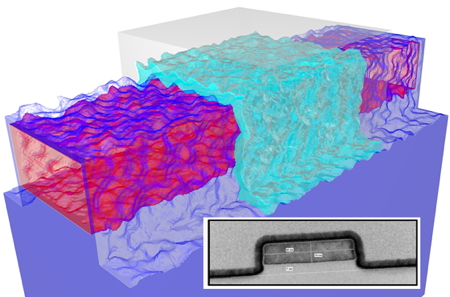The industry of microelectronics has constantly sought to reduce the characteristic dimensions of transistors in order to increase their performance and to incorporate more and more on a single chip. The "length" of a transistor has now reached 22 nm, and should surpass the 10 nm by 2020. This evolution was accompanied by profound changes, with the introduction of new materials (oxides of hafnium, ...) and the appearance of new architectures of components (" FDSOI " transistors on thin films " Trigate " transistors with nanowire..). Reducing the size and dimensionality of the transistors, however, exacerbated non-local quantum effects, which complicate the qualitative and quantitative analysis of these systems.
Modeling has an important role to play in the understanding of these devices and the choice of technology options. However, quantum corrections are poorly captured by the methods of semi -classical simulation commonly used in microelectronics. We have developed a quantum simulation code based on the method of Green's functions off- equilibrium. This
TB_Sim code, received third prize in the Bull - Fourier competition in 2012 for his performance on supercomputers of CCGT in Paris.
This year, we used to TB-Sim code to model the latest FDSOI technology from STMicroelectronics, and the upcoming Trigate technologies that are in preparation in Leti. In STMicroelectronics FDSOI transistors, current flows in a 7 nm thick silicon film. An electrode on the back of the film allows to optimize performance and power consumption of transistors depending on their activity: this is a significant advantage for low-energy applications. In the Leti Trigate transistors, current flows in a silicon wire with dimensions of the order of 10 nm. Many questions remain open concerning the physics of these devices. To answer these questions, we conducted simulations on extremely realistic geometries, taking into account the main mechanisms limiting the current: Coupling between electrons and the atomic lattice vibrations, interactions of electrons with surfaces and trapped charges, etc ... We were able to quantify the impact of each mechanism, and make decisive progress in the understanding of these devices. For example, we clarified the role played by the charges trapped in the oxide and analyzed in detail the action of the rear electrode of the charge carriers. We even revealed new mechanisms of electron scattering!
We have thus demonstrated the relevance of these quantum solvers for modeling ultimate devices.
These calculations are the result of an active collaboration between Inac, CEA and STMicroelectronics in the frame of the Quasanova ANR project (financed by the National Research Agency ANR). They were carried out on supercomputers of the TGCC at Bruyeres-le-Chatel through national (GENCI) and Europe (PRACE) and European allocations.

Simulation and TEM image of a TriGate transistor.